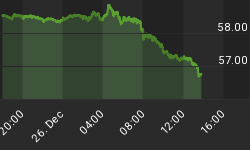Below is an excerpt from a commentary originally posted at www.speculative-investor.com on 22nd March 2009.
Short-term moves in the gold market are generally more subject to sentiment swings, reactions to news events and randomness than to changes in the fundamentals. It is therefore impossible to consistently predict, and often difficult to explain, the short-term moves. However, on a long-term basis the gold price generally does what it should do based on our understanding of its most important fundamental drivers, which is why we rarely devote any space at TSI to gold market manipulation. We'll use the following long-term chart of the gold/CRB ratio (gold relative to a basket of commodities) to illustrate what we mean.
When confidence in financial assets and the economy's prospects is high or on the rise there should be relatively less demand for the safety offered by gold and relatively more demand for commodities that benefit from stronger economic growth, with the opposite being the case when confidence is on the decline. The gold/CRB ratio should therefore move counter to the broad stock market over the long-term.
Move counter to the broad stock market is exactly what the gold/CRB ratio has done. As noted on the following chart, gold/CRB's 1980 peak and 2000 nadir roughly coincided with the start and end, respectively, of the long-term bull market in US equities. The initial rise in the gold/CRB ratio from its 2000 low was propelled by the 2000-2002 financial crisis, but it wasn't until the more severe crisis of 2008 that gold/CRB broke decisively above its long-term base and rocketed upward.

To match its trough-to-peak performance of the 1970s the gold/CRB ratio will have to rise to around 8, or about 60% above last month's peak. We think it will ultimately do better than that because the monetary system is now in a more precarious state than it was during the 70s, but gold/CRB's almost vertical 6-month rise should give gold bulls (like us) a reason to stop and think. If we are into the final 12 months of the gold bull market then a continuation of the vertical rise would be the most reasonable expectation, but if the bull market still has at least a few years to run (our view) then it is more reasonable to expect a period of consolidation prior to further gains.
We aren't offering a free trial subscription at this time, but free samples of our work (excerpts from our regular commentaries) can be viewed at: http://www.speculative-investor.com/new/freesamples.html.
















